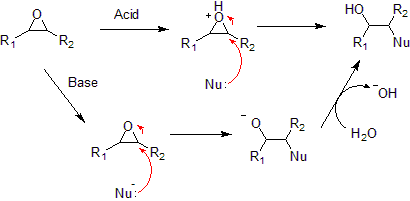Epoxide

An epoxide is a cyclic ether with three ring atoms. This ring approximately defines an equilateral triangle, which makes it highly strained. The strained ring makes epoxides more reactive than other ethers. Simple epoxides are named from the parent compound ethylene oxide or oxirane, such as in chloromethyloxirane. As a functional group epoxides feature the epoxy prefix such as in the compound 1,2-epoxycycloheptane which can also be called cycloheptene epoxide, or simply cycloheptene oxide.
A polymer containing unreacted epoxide units is called a polyepoxide or an epoxy. Epoxy resins are used as adhesives and structural materials. Polymerization of an epoxide gives a polyether, for example ethylene oxide polymerizes to give polyethylene glycol, also known as polyethylene oxide.
Synthesis
The dominant epoxides industrially are ethylene oxide and propylene oxide, which are produced respectively on the scales of approximately 15 and 3 million tonnes.[1] The epoxidation of ethylene involves its catalytic reaction of oxygen according to the following stoichiometry:
- 7 H2C=CH2 + 6 O2 → 6 C2H4O + 2 CO2 + 2 H2O
The direct reaction of oxygen with alkenes is useful only for this epoxide. Other alkenes fail to react usefully, even propylene.
Olefin peroxidation
Most epoxides are generated by treating alkenes with peroxide-containing reagents, which donates a single oxygen. Typical peroxide reagents include hydrogen peroxide, peroxycarboxylic acids (generated in situ or preformed), and alkyl hydroperoxides. In specialized applications, other peroxide-containing reagents are employed, such as dimethyldioxirane.
The largest scale application of this approach is the production of propylene oxide from propylene using either t-butyl hydroperoxide or ethylbenzene hydroperoxide.[2] More typically for laboratory operations, the Prilezhaev reaction is employed.[3][4] This approach involves the oxidation of the alkene with a peroxyacid such as m-CPBA. Illustrative is the epoxidation of styrene with perbenzoic acid to styrene oxide:[5]
The reaction proceeds via what is commonly known as the "Butterfly Mechanism."[6] The peroxide is viewed as an electrophile, and the alkene a nucleophile. The reaction is considered to be concerted (the numbers in the mechanism below are for simplification).
Hydroperoxides are also employed in catalytic enantioselective epoxidations, such as the Sharpless epoxidation and the Jacobsen epoxidation. In such cases the oxygen is delivered from a metal oxide or peroxide. Together with the Shi epoxidation, these reactions are useful for the synthesis of chiral epoxides.
Intramolecular SN2 substitution
This method is a variant of the Williamson ether synthesis. In this case, an alkoxide ion intramolecularly displaces a chloride. The precursor compounds are called halohydrins. For example, with 2-chloropropanol:[7] Approximately half of the world's supply of propylene oxide arises via this route.[2]
Johnson-Corey-Chaykovsky reaction
In the Johnson-Corey-Chaykovsky reaction epoxides are generated from carbonyl groups and sulfonium ylides.
Reactions
Typical epoxide reactions are listed below.
- Nucleophilic addition to an epoxide can be base or acid catalyzed.

- Under acidic conditions, the nucleophile attacks the carbon that will form the most stable carbocation, i.e. the most substituted carbon (similar to a halonium ion). Under basic conditions, the nucleophile attacks the least substituted carbon, in accordance with standard SN2 nuclephilic addition reaction process.
- Hydrolysis of an epoxide in presence of an acid catalyst generates a glycol. The hydrolysis process of epoxides can be considered to be the nucleophilic addition of water to the epoxide under acidic conditions.
- Reduction of an epoxide with lithium aluminium hydride and water generates an alcohol. This reduction process can be considered to be the nucleophilic addition of hydride (H-) to the epoxide under basic conditions.
- Reduction with tungsten hexachloride and n-butyllithium generates the alkene. This reaction in effect is a de-epoxidation:[8]
Perepoxides
Perepoxides are epoxides with an additional oxygen atom. They are isoelectronic and isostructural with related sulfoxides derived from episulfides, which well characterized. Perepoxides are proposed intermediates in the photosensitized oxidation of alkenes, as occurs when drying oils (a component of some paints and varnishes) are exposed to air in light. Such intermediates arise from the addition of singlet oxygen to the double bond. Perepoxides rapidly rearrange to the allylic hydroperoxide.[3]
See also
References
- ^ Siegfried Rebsdat, Dieter Mayer "Ethylene Oxide" in Ullmann's Encyclopedia of Industrial Chemistry, Wiley-VCH, Weinheim, 2005.doi:10.1002/14356007.a10_117 Article Online Posting Date: March 15, 2001.
- ^ a b Dietmar Kahlich, Uwe Wiechern, Jörg Lindner “Propylene Oxide” in Ullmann's Encyclopedia of Industrial Chemistry, 2002 by Wiley-VCH, Weinheim. doi:10.1002/14356007.a22_239Article Online Posting Date: June 15, 2000
- ^ a b March, Jerry. 1985. Advanced Organic Chemistry, Reactions, Mechanisms and Structure. 3rd ed. John Wiley & Sons. ISBN 0471854727.
- ^ Nikolaus Prileschajew (1909). "Oxydation ungesättigter Verbindungen mittels organischer Superoxyde". Berichte der deutschen chemischen Gesellschaft. 42 (4): 4811–4815. doi:10.1002/cber.190904204100.
- ^ Harold Hibbert and Pauline Burt (1941). "Styrene Oxide". Organic Syntheses; Collected Volumes, vol. 1, p. 494.
- ^ Bartlett Rec. Chem. Prog 1950, 11 47.
- ^ Koppenhoefer, B.; Schurig, V. (1993). "(R)-Alkyloxiranes of High Enantiomeric Purity from (S)-2-Chloroalkanoic Acids via (S)-2-Chloro-1-Alkanols: (R)-Methyloxirane". Organic Syntheses
{{cite journal}}: CS1 maint: multiple names: authors list (link); Collected Volumes, vol. 8, p. 434. - ^ K. Barry Sharpless, Martha A. Umbreit, Marjorie T. Nieh, Thomas C. Flood (1972). "Lower valent tungsten halides. New class of reagents for deoxygenation of organic molecules". J. Am. Chem. Soc. 94 (18): 6538–6540. doi:10.1021/ja00773a045.
{{cite journal}}: CS1 maint: multiple names: authors list (link)




